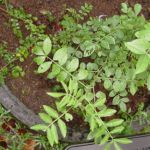| Common Name: |
Chinese Licorice |
| Other Names: |
Manchurian Licorice |
| Botanical Name: |
Glycyrrhiza uralensis syn G. viscida |
| Genus: |
Glycyrrhiza |
| Family: |
Papilionaceae |
| Native Location: |
C Asia, China, Japan |
| Cultivation: |
Deep, rich, sandy soil in sun. Slightly alkaline, moisture-retentive conditions give the best results. Remove flower heads to encourage stronger roots and stolons, unless seed is required. Difficult to eradicate when well established. |
| Propagation: |
By seed sown in spring; by division in autumn or spring; by stolon cuttings in spring. Seeds should be scarified or soaked overnight to speed germination. Seedlings are slow growing. |
| Harvest: |
Roots and stolons are lifted in early autumn, 3-4 years after planting, and dried for decoctions, liquid extracts, lozenges, and powder, or crushed and boiled to produce juice which is evaporated and rolled into sticks or cakes. |
| Height: |
40cm-1m (16-36in) |
| Width: |
30-60cm (12-24in) |
| Hardiness: |
Z9-10 |
| Parts Used: |
Roots,(gan cao). |
| Properties: |
A sweet, tonic herb that stimulates adrenocorticol hormones, relaxes spasms, reduces pain and inflammation, is expectorant, and laxative, and controls coughing. It also neutralizes toxins and balances blood sugar levels. |
| Medicinal Uses: |
Internally for Addison's disease, asthma, coughs, and peptic ulcer; externally for acne (combined with flowers of Lonicera japonica,, See, Japanese honeysuckle), boils, and sore throat. Added to almost all formulas to harmonize and direct the effects of the various ingredients. Combined with Panax ginseng (See, ginseng) as an energy tonic. Precipitates many compounds, therefore considered incompatible with Daphne genkwa (See, daphne genkwa), Euphorbia kansui (See, asthma weed), E. pekinensis (See, pill-bearing spurge) and Sargassum fusiforme (See, gulfweed); reduces effectiveness of Coptis chinensis (See, Chinese goldthread), Corydalis solida (See, fumewort), and Tetradium ruticarpum (See, Tetradium ruticarpum); increases toxicity of salicylates, ephedrine, adrenaline, oral hypoglycemics, and cortisone. Contraindicated in pregnancy, anemia, hypertension, kidney disease, and for patients taking digoxin-based medication. Excess causes water retention and high blood pressure. Hormonal effects may cause impotence. For use by qualified practitioners only. |
| Culinary Uses: |
Roots ("licorice sticks") are chewed as candy. |
| Economic Uses: |
Licorice extract and powder are used in candy and to flavor tobacco, beer, soft drinks, and pharmaceutical products (notably laxatives); also as an ingredient in herb teas, a foaming agent in beers and fire extinguishers, and colorant in stout. |
| Bibliography: |
Encylopedia of Herbs by Deni Brown Copyright ©: 1995, 2001 Dorling Kindersley Limited pps. 226-227
|

